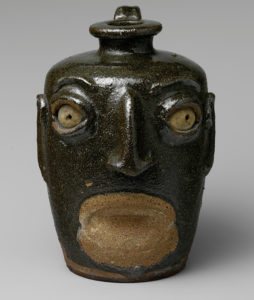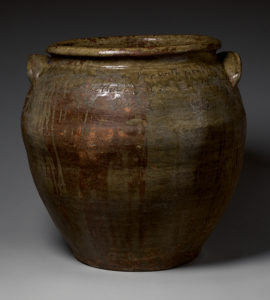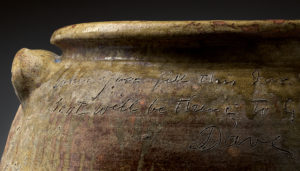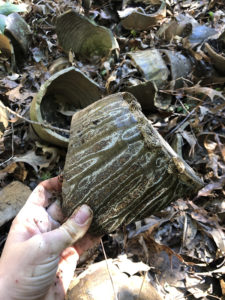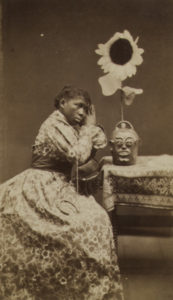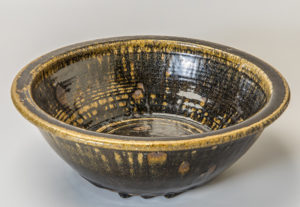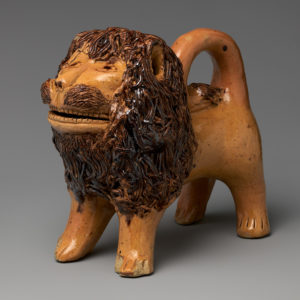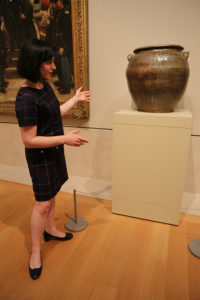Examining Edgefield Stoneware at The Met
EMERGING SCHOLARS > SUMMER RESEARCH GRANTS
by Katherine C. Hughes
Thanks to the generosity of the Decorative Arts Trust and the Gerry Charitable Trust, in September 2018 I joined The Metropolitan Museum of Art’s (The Met’s) American Wing as the Peggy N. Gerry Research Scholar, under the direction of Sylvia Yount, Lawrence A. Fleischman Curator in Charge, and the supervision and mentorship of Adrienne Spinozzi, Assistant Research Curator. I hoped to gain valuable experience researching and organizing an exhibition on the 19th-century stoneware of South Carolina’s Old Edgefield District that would draw on and utilize my combined passions for Southern decorative arts, folk art, material culture, the history of African American craftsmen, and the study of ceramics. As my work has evolved, I have delved deeply into that project while traveling, speaking, and developing relationships with the broader ceramics field and the Edgefield research community.
The majority of my work, including related travel and speaking opportunities, has revolved around The Met’s upcoming exhibition of 19th-century alkaline-glazed stoneware from Edgefield District. A monumental 19th-century pottery production site, Edgefield District is central to the study of Southern decorative arts. The ceramics made there range from enigmatic face vessels (figures 1 and 2) to David Drake’s massive storage jars incised with poetry and his signature (figures 3 and 4). Drake (c. 1801–1870s) and his fellow craftsmen and laborers, many of whom are still anonymous, were largely enslaved African Americans. Post-emancipation, many remained at the potteries producing wares for sale. Their efforts represent an important and lasting legacy of the often unrecognized labor of marginalized communities in the decorative arts field.
One of my initial projects upon my arrival at The Met last fall was creating an inventory of known 19th-century Edgefield District face vessels. This database currently contains over 150 objects, with vital information, including manufacturing dates, makers (if known), provenance, current location (if known), and additional notes, and is supplemented by a visual board of images. This research has been made possible by travel to private collections in South Carolina, Michigan, Virginia, and Alabama, and with institutional collections throughout the United States. In September, Adrienne and I organized a regional “study day” during which we examined many face vessels firsthand, along with a conservator and scientist from The Met. The information gathered has proved invaluable to how we think of the creation and function of these objects. The database, which is currently being used solely for in-house research, has the potential to develop into a public online database replete with images of extant examples, measurements, publication and exhibition history, and publicly documented provenance. The visual board has been a key tool in tracking and understanding multiple schools of face vessels of similar size, style, and/or facial features, and it provides a starting point for thinking about the still unidentified craftsmen who made these objects and the kilns from which they originated.
At the beginning of 2019, I joined Adrienne on a week-long research trip to South Carolina and Georgia, which included visits to private and public collections, appointments in museum storage and archives, and a full day accompanying archaeologists on visits to former 19th-century pottery sites (figure 5). A key aspect of this trip was viewing and directly handling Edgefield stoneware, with the goal of refining the proposed object checklist for the exhibition, an important milestone in the project’s development. Adrienne and I returned to South Carolina this summer accompanied by our colleagues from The Met’s Conservation and Scientific Research departments to conduct additional material and elemental analysis on vessels still located in early institutional collections and private homes in the region. This analysis will help to illuminate the functional use of these wares in food preparation and storage, and potentially reveal more information about the people who used them. Such detailed information enriches our understanding of 19th-century foodways of the region and provides museum guests with a fuller picture of life in the Antebellum South.
In April, I undertook another trip to Columbia, SC, to visit the South Caroliniana Library at the University of South Carolina. The Caroliniana holds an extensive collection of late-19th-century images of South Carolina by photographer James A. Palmer (1825–1896). Two of the images from Palmer’s “Aiken and Vicinity” series (figure 6) are recent acquisitions of the American Wing and will be featured in The Met’s Edgefield exhibit alongside a face vessel in the American Wing’s collection that relates to one seen in the images (figure 7). As part of my research, I created a listing of Palmer’s known images from this series, which has helped us establish the novelty of this pair of racially and culturally offensive images. I will be conducting further research on Palmer and the iconography within the images during my remaining time at The Met. As well as these trips, I have traveled to an array of other institutions to study and discuss Edgefield stoneware in their collections, including the Chipstone Foundation, the Colonial Williamsburg Foundation, and the Smithsonian National Museum of American History.
In addition to exhibit-related research travel, I have supplemented my research by attending and presenting at a number of conferences and field studies.
Through the generosity of the Decorative Arts Trust, I was invited to speak at the 71st Colonial Williamsburg Antiques Forum, held in February 2019, as a Mike and Carolyn McNamara Young Scholar Lecturer. I presented my research on an Edgefield stoneware bowl in the MESDA collection (figure 8), incorporating research from the previous summer as a student in MESDA’s Summer Institute, as well as more recent work undertaken during my time at The Met.
I returned to Williamsburg a few weeks later to contribute to the panel “Objects and Places: Telling the Truth and its Consequences,” during the College of William and Mary’s annual Lemon Project Symposium. The symposium focuses on the relationship between African Americans and the College and is part of the Universities Studying Slavery Consortium. This panel, which brought together individuals with varying backgrounds and professional museum experience, focused on issues inherent in teaching African American history, asking what the role of researchers and professionals in a community should be and if museums and classrooms have a role in the reconciliation of trauma. We also discussed whether it is possible to successfully tell the “full” history in museum settings, using The Met’s upcoming Edgefield exhibit as a tangible case study.
This past fall, I was privileged to contribute to a panel at the annual meeting and conference of the Association for the Study of African American Life and History (ASALH) held in North Charleston, SC. I shared my research on 19th-century Edgefield District stoneware and its makers during a discussion on “Migrations and Material Culture” as they relate to the African American experience. The audience posed some wonderful questions, and I felt energized and inspired upon leaving. The conversations at ASALH reinforced my belief that decorative arts and material culture, and Edgefield pottery especially, touch on important topics that need to be addressed. The opportunity to share and engage with new and diverse communities and audiences, both during the research and exhibition building process, as well as in the museum galleries themselves, is a responsibility I do not take lightly.
My Edgefield-related responsibilities require collaborating with others both in the American Wing and across the Museum, including curators, technicians, conservators, scientists, volunteers, and fellows. Additional aspects of my role include building a bibliography of Edgefield and related southern ceramics publications, and making recommendations for the American Wing Library. I have also participated in discussions with Exhibitions, Education, Editorial, as well as Conservation and Scientific Research.
Augmenting my work on the Edgefield exhibit, I have had the opportunity to contribute to the Wing in myriad other ways, including assisting the collections manager on redistributing a collection of antique books and participating in discussions on the reevaluation of the Luce Center Visible Storage display. A favorite project was writing the accession paperwork for a unique 19th-century stoneware lion, and then researching a related earthenware example already in the collection (figures 9 and 10). I have written labels for both figures, as well as an important stoneware water cooler, which are displayed as part of the current folk art exhibition. In the coming months, I will be co-curating a small case installation on Tucker porcelain with Alice Cooney Frelinghuysen, Anthony W. and Lulu C. Wang Curator of American Decorative Arts.
I have participated in a variety of departmental activities, including a series of 15-minute talks for the exclusive Member Grand Tour evening in the spring (figure 11). I also co-lead a private tour of the American Wing for guests interested in early stoneware objects in the collection. Other experiences include attending an art pottery Scholar’s Day, presenting to the William Cullen Bryant Fellows during their annual meeting, and joining the esteemed Met Fellows in their orientation and museum-wide programming.
Looking to the next year, I will continue contributing to the face vessel database, researching the provenance and wider history of objects being featured in the 2022 exhibition, and writing a number of object entries for the accompanying catalog. I am also involved in the planning of an invitational advisory convening on issues of interpretation and inclusivity in advance of The Met’s Edgefield exhibit, as well as planning for the 2020 American Ceramic Circle’s 50th annual symposium, to be hosted by The Met next fall. Additionally, I am looking forward to developing a lecture and tour for members of the Decorative Arts Trust in the coming months.
This two-year intensive experience will allow me to participate in the creation of an exhibition from start to finish and to gain an in-depth understanding of the intricate workings of an institution of this size. Being at The Met every day is an extraordinary education—walking amongst one of the greatest art collections in the world, effectively traveling through time, cultures, and history, without ever stepping outside the building. The tea and friendship I have shared with my fellow colleagues has been an invaluable support during my time thus far and a gift I will carry with me when I leave.
The array of professional experiences I have had at The Met have refined my curatorial, research, and public presentation skills and better prepared me for a career working with objects and material culture in an historic context. I will continue to develop those skills as I seek to share my research and passion for the field to new and broadening audiences at The Met and other institutions as my career progresses. I would like to thank the Decorative Arts Trust, which has been instrumental to my experience as a student and young professional (beginning with a Dewey Lee Curtis Scholarship to attend the Bermuda symposium in the spring of 2014), and I am sincerely grateful to the Trust, the Gerry Charitable Trust, and the American Wing for awarding me this wonderful opportunity.
Katherine C. Hughes is the Peggy N. Gerry Research Scholar at The Metropolitan Museum of Art’s American Wing.
A print version of this article was published in The Magazine of the Decorative Arts Trust, one of our most popular member benefits. Join today!

